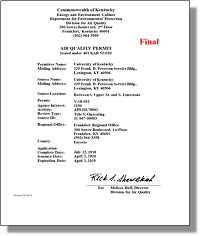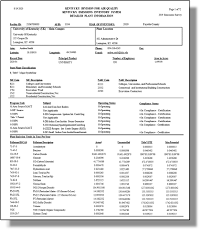UK Title V Permit
History
The University’s main campus located in Lexington is required to obtain approval for the construction and operation of any affected facility (apparatus, building, operation, road, or other entity) that could potentially emit any regulated or hazardous air pollutant (HAP) as defined by the Clean Air Act. For the University’s permit, the affected facilities are stationary sources (e.g., boiler) often referred to as an emission unit which is any part or activity of a source that emits a regulated air pollutant or HAP (e.g., boiler stack). Therefore, the permitted equipment is referred to interchangeably as an affect facility, source, or emission unit. Further,̶ the University’s main campus as a whole is referenced as a source meaning there are one or more affected facilities within a given property line.
The permitting process for air emissions has evolved. Previously the University received a permit to construct an emission unit and another permit to operate it. Rarely would one comprehensive operating permit be issued and the University had to rely on multiple permits to form a complete list of permitted requirements. With the Clean Air Act Amendments of 1990, the Title V program was established to standardize air quality permits and the permitting process through a national operating permit process. A Title V permit contains all regulated emission units on one permit and as construction or modifications are made, a new Title V permit is issued containing all previous emission units and as well as any new emission units or modifications to existing emission units.
The Permit
The EPA has delegated Title V permitting authority to the Kentucky Division for Air Quality (KDAQ). As such, all Title V permits in the Commonwealth must be issued through KDAQ. There are multiple Title V permit classifications. The University’s permit is classified as a major source with potential emissions of 100 tpy of any regulated pollutant, 10 tpy of any single HAP, and 25 tpy of any combination of HAPs. However, operating limitations were taken to remain a minor classification with regards to HAPs.
The University is permitted to operate 10 dual-fired natural gas/diesel boilers, 4 coal-fired boilers, 25 natural gas-fired boilers, eighty-eight (88) diesel-fired emergency generators, 15 natural gas-fired emergency generators, 2 paint booths, and various insignificant activities.
The Title V permit is divided into multiple Sections A – I. Although important, Sections A, and E – I are general permitting conditions applicable to all Title V permits issued by KDAQ. However, Sections B – D contain requirements specific to the University.
Section B designates an emission unit (EU) number to each permitted source and provides a relevant description. Sources with the same applicable regulations are grouped to prevent redundancy. For each source, the permit establishes operating and emission limitations and testing, monitoring, recordkeeping, and reporting requirements.
Section C contains all sources deemed as insignificant activities.
Section D establishes operating and emission limitations and testing, monitoring, recordkeeping, and reporting requirements applicable to multiple or all sources.
Although all the requirements in Sections B and D are too numerous to individually list on this site, they are directly or indirectly reflected in the reports submit to KDAQ.
University Reporting Requirements
To demonstrate permit compliance, the University is required to report multiple parameters to KDAQ and EPA throughout the year. Reporting of sources is based on requirements of an applicable regulation or to preclude a regulation.
Emissions Inventory Survey – Applicable to all sources – Submit to KDAQ in the 1st quarter
- All sources
- Report actual annual throughput(s) of each source for the previous calendar year to calculate emissions released from the activity
Quarterly Reports – Applicable to specific sources – Submit to KDAQ 30-days after end of quarter
- Coal-fired boilers (EU 07, 08, 13(01, 02))
- Report opacity or sulfur dioxide emission excursions
- Duel-fired natural gas/fuel oil boilers (EU 01, 02, 15, 16)
- Report nitrogen oxides excursions and continuous emissions monitor performance
Semi-Annual Reports – Applicability varies from specific sources to all sources – Submit to KDAQ June 30 and January 30
- Coal-fired boilers (EU 07, 08, 13(01, 02))
- Report monthly and 12-month rolling total of coal usage
- Report steam and oxygen recorder performance, 30-day rolling averages, and excursions
- All sources
- Report monthly and 12-month rolling Hazardous Air Pollutant emissions
- Report individual monthly and 12-month rolling run hours and fuel usage
- Duel-fired natural gas/fuel oil boilers (EU 01, 02, 15, 16)
- Report nitrogen oxides monthly and 12-month rolling 30-day rolling averages
- Report nitrogen oxides excursions and continuous emissions monitor performance
- Report cylinder gas and relative accuracy test audit results and calibration drift excursions
- Natural gas-fired boiler (EU 51), diesel-fired emergency generator (EU 53)
- Report combined monthly and 12-month rolling carbon monoxide, nitrogen oxides, and sulfur dioxide emissions
- Duel-fired natural gas/fuel oil boilers (EU 15, 16), diesel-fired emergency generators (EU 60-67)
- Report combined monthly and 12-month rolling carbon monoxide, nitrogen oxides, and sulfur dioxide emissions
- Diesel-fired emergency generators (EU 60-67)
- Report combined monthly and 12-month rolling run hours
- Combined emergency generators (EU 54-56, 60-62, 63-66, 67-69, 70-71)
- Report combined monthly and 12-month rolling run hours and fuel usage
Annual Compliance Certification – Applicable to all sources – Submit to KDAQ and EPA January 30
- All sources
- Report compliance status of all permit terms, conditions, or applicable regulation.
Test Reports – Applicable to specific sources – Submit to KDAQ and EPA 45 days after test
- Coal-fired boilers (EU 07, 08, 13(01, 02))
- Report stack test
- Duel-fired natural gas/fuel oil boilers (EU 01, 02, 15, 16)
- Report relative accuracy test audit
Documents
 Title V Permit Title V Permit |
 Emissions Inventory Report Emissions Inventory Report |
